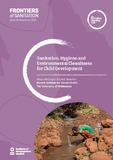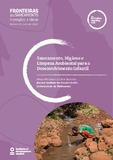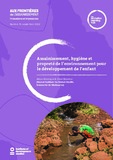Sanitation, Hygiene and Environmental Cleanliness for Child Development
Saneamento, Higiene e Limpeza Ambiental para o Desenvolvimento Infantil;
Assainissement, hygiène et propreté de l’environnement pour le développement de l’enfant
| dc.contributor.author | Macintyre, Alison | |
| dc.contributor.author | Strachan, Clare | |
| dc.date.accessioned | 2021-11-23T14:42:57Z | |
| dc.date.available | 2021-11-23T14:42:57Z | |
| dc.date.issued | 2021-11-23 | |
| dc.identifier.citation | Macintyre, A and Strachan, C. (2021) ‘Sanitation, Hygiene and Environmental Cleanliness for Child Development’ Frontiers of Sanitation: Innovations and Insights 19, Brighton: IDS, DOI: 10.19088/SLH.2021.022 | en |
| dc.identifier.citation | Macintyre, A e Strachan, C. (2021) ‘Saneamento, Higiene e Limpeza Ambiental para o Desenvolvimento Infantil’ Fronteiras do Saneamento Inovações e Ideias 19, Brighton: IDS, DOI: 10.19088/SLH.2022.009 | pt |
| dc.identifier.citation | Macintyre, A et Strachan, C. (2022) « Assainissement, hygiène et propreté de l’environnement pour le développement de l’enfant » Aux Frontières de l’assainissement : Innovations et Impressions 19, Brighton IDS. DOI : 10.19088/SLH.2022.015 | fr |
| dc.identifier.isbn | 978-1-78118-880-4 | |
| dc.identifier.isbn | 978-1-80470-007-5 | |
| dc.identifier.uri | https://opendocs.ids.ac.uk/opendocs/handle/20.500.12413/16954 | |
| dc.description.abstract | This Frontiers of Sanitation draws on the Transformative WASH concept to explore and outline what may be required of WASH implementation stakeholders in efforts to support child development outcomes. The Frontiers explores the multiple ways in which inadequate sanitation, hygiene, and environmental cleanliness can affect physical and cognitive development in children. It explores areas beyond hand hygiene to consider food hygiene and broader environmental cleanliness, and beyond human faeces to consider animal faeces. What this means for practice is then discussed to outline how the WASH sector can improve current practice to best support improvements to child development outcomes and in particular opportunities for children to both survive and thrive. | en |
| dc.description.abstract | Este Fronteiras ... baseia-se no conceito de WASH Transformativo ao explorar e delinear o que pode ser exigido aos intervenientes na implementação de WASH nos esforços para apoiar os resultados do desenvolvimento infantil. Este número de Fronteiras... explora as múltiplas formas como o saneamento inadequado, a higiene e a limpeza ambiental podem afectar o desenvolvimento físico e cognitivo das crianças. Explora áreas para além da higiene das mãos, ao considerar a higiene alimentar e a limpeza ambiental mais alargada e vai além das fezes humanas, ao ter em conta as fezes animais. É então discutido o que isto implica na prática, por forma a delinear o aperfeiçoamento das práticas actuais do sector de WASH, visando a obtenção de melhores resultados no desenvolvimento infantil e, em particular, de melhores oportunidades de as crianças sobreviverem e se desenvolverem. | pt |
| dc.description.abstract | Ce numéro d’Aux Frontières de l’assainissement s’appuie sur le concept de WASH transformationnel pour explorer et décrire brièvement ce que l’on peut attendre des parties prenantes à la mise en oeuvre des services d’EAH pour soutenir le développement infantile. Frontières explore les multiples façons qui font qu’une hygiène et un assainissement insuffisants ainsi qu’un manque de propreté de l’environnement peuvent affecter le développement physique et cognitif des enfants. Il va plus loin que l’hygiène des mains pour considérer l’hygiène alimentaire et la propreté de l’environnement en général et il va au-delà des excreta humains pour considérer les déjections animales. Concrètement, ce que cela veut dire est alors discuté pour décrire comment le secteur de l’EAH peut améliorer les pratiques pour mieux soutenir les améliorations apportées au développement infantile et, en particulier, les opportunités qui s’offrent aux enfants pour survivre et s’épanouir. | fr |
| dc.description.sponsorship | Sida | en |
| dc.language.iso | en | en |
| dc.publisher | The Sanitation Learning Hub, Institute of Development Studies | en |
| dc.relation.ispartofseries | Frontiers of Sanitation: Innovations and Insights;19 | |
| dc.rights | This series is licensed under the Creative Commons Attribution-Non- Commercial-NoDerivs 3.0 Unported License (http://creativecommons. org/licenses/by-nc-nd/3.0/). Attribution: You must attribute the work in the manner specified by the author or licensor. Non-commercial: You may not use this work for commercial purposes No Derivative Works: You may not alter, transfer, or build on this work. Users are welcome to copy, distribute, display, translate or perform this work without written permission. For any reuse or distribution, you must make clear to others the licence terms of this work. If you use the work, we ask that you reference the SLH website (https:// sanitationlearninghub.org/) and send a copy of the work or a link to its use online to the following address: The Sanitation Learning Hub, Institute of Development Studies, University of Sussex, Brighton, BN1 9RE, UK (SLH@ids.ac.uk). Consent has been given to take and use all of the photos in this publication. | en |
| dc.rights.uri | http://creativecommons.org/licenses/by-nc-nd/3.0/ | en |
| dc.subject | Children and Youth | en |
| dc.subject | Environment | en |
| dc.subject | Health | en |
| dc.subject | Water | en |
| dc.title | Sanitation, Hygiene and Environmental Cleanliness for Child Development | en |
| dc.title | Saneamento, Higiene e Limpeza Ambiental para o Desenvolvimento Infantil | pt |
| dc.title | Assainissement, hygiène et propreté de l’environnement pour le développement de l’enfant | fr |
| dc.type | Series paper (non-IDS) | en |
| dc.rights.holder | The Sanitation Learning Hub | en |
| dc.identifier.team | Participation | en |
| dc.identifier.doi | 10.19088/SLH.2021.022 | |
| dc.identifier.doi | 10.19088/SLH.2022.009 | pt |
| dc.identifier.doi | 10.19088/SLH.2022.015 | |
| dcterms.dateAccepted | 2021-11-23 | |
| rioxxterms.funder | Default funder | en |
| rioxxterms.identifier.project | The Sanitation Learning Hub | en |
| rioxxterms.version | VoR | en |
| rioxxterms.versionofrecord | 10.19088/SLH.2021.022 | en |
| rioxxterms.funder.project | 44cbea9c-3179-456c-bc3f-9b7cd4f89d0d | en |
Files in this item
This item appears in the following Collection(s)
Except where otherwise noted, this item's license is described as This series is licensed under the Creative Commons Attribution-Non-
Commercial-NoDerivs 3.0 Unported License (http://creativecommons.
org/licenses/by-nc-nd/3.0/).
Attribution: You must attribute the work in the manner specified by the
author or licensor.
Non-commercial: You may not use this work for commercial purposes
No Derivative Works: You may not alter, transfer, or build on this work.
Users are welcome to copy, distribute, display, translate or perform
this work without written permission. For any reuse or distribution,
you must make clear to others the licence terms of this work. If you
use the work, we ask that you reference the SLH website (https://
sanitationlearninghub.org/) and send a copy of the work or a link to
its use online to the following address: The Sanitation Learning Hub,
Institute of Development Studies, University of Sussex, Brighton, BN1
9RE, UK (SLH@ids.ac.uk). Consent has been given to take and use all
of the photos in this publication.




